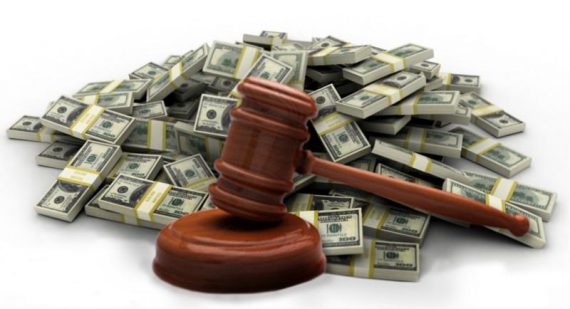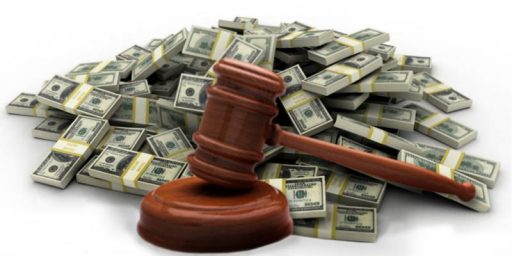Who Should Pay Child Porn Victims? And How Much?
A man who viewed two photographs of a child abuse victim has been ordered to pay $3.4 million in damages.
A man who viewed two photographs of a child abuse victim has been ordered to pay $3.4 million in damages.
WaPo (“Supreme Court weighs how much one person should pay pornography victim“):
A woman with the pseudonym Amy Unknown was at the Supreme Court on Wednesday as justices discussed the horrible events that changed her life: Her uncle raped her when she was a young girl, recorded that assault and other sex acts and put the images on the Internet, where they have been viewed tens of thousands of times.
All the justices seemed to think that those who downloaded the images of Amy should pay to help her put her life back together. But they struggled to decide what any one person should pay.
Congress made it clear in 1994 that victims such as Amy deserved restitution from those who have viewed the pornographic images that feature them. The cost of Amy’s abuse, according to a psychological report that described her trauma and ongoing counseling and medical treatment, is $3.4 million.
The immediate question before the justices was how much of that should be paid by a Texas man named Doyle Randall Paroline.
Paroline pleaded guilty in 2009 to possessing 300 images of child pornography, including two of Amy. He was sentenced to prison. And on the matter of how much money he owes Amy, the U.S. Court of Appeals for the 5th Circuit said all $3.4 million.
The court based its decision on a section of the law that said courts are directed to make the defendant pay “the full amount of the victim’s losses.” The court’s reading of the law conflicts with those of other courts, but Amy’s attorney Paul G. Cassell said it was proper.
“Congress wanted to take these vulnerable victims — child pornography crimes, federal sex offense crimes and domestic violence — and get them full restitution as quickly and effectively as possible,” said Cassell, a law professor at the University of Utah and a former federal judge.
Some justices said Congress surely meant that courts should consider how much a defendant had contributed to the victim’s suffering.
“He’s guilty, he’s guilty of the crime,” Justin Antonin Scalia said of Paroline. “But to sock him for all of her psychiatric costs and everything else because he had two pictures of her? Congress couldn’t have intended that.”
But Cassell said Congress could not have intended to send Amy on the hunt for defendants to sue. Alerted by the government when an image of her is discovered, it has taken Amy 41/ 2 years to collect $1.75 million, from 182 defendants ($1.2 million came from one man). Cassell said it is estimated that more than 70,000 people have seen Amy’s image.
If each defendant was tagged with the total cost, Cassell said, Amy might receive the restitution quickly from one or more wealthy individuals. The hunt would then be over, and she would receive no more than the $3.4 million the court approved.
Paroline’s attorney, Stanley G. Schneider, on the other hand, said his client should not have to pay anything, which is what a district judge decided.
Schneider, who was appointed by the court to represent Paroline, said so many people have seen Amy’s image that the government could not prove it was Paroline who has caused her suffering.
Justice Elena Kagan said that could not be right.
“If only one person viewed the pornography, that person would be responsible for the entire damages, but if 1,000 people viewed the pornography and the harm was that much greater, nobody would be on the hook for restitution?” she said. “How could that possibly make sense?”
The answer here seems stunningly obvious, yet Congress, the lower courts, and two brilliant Supreme Court justices have missed it: The uncle is the abuser here, has caused one hundred percent of the damage, and therefore should be held solely liable. He raped her. He photographed his crimes and her suffering. He uploaded the images to the Internet to further her humiliation.
To be sure, those who view, and presumably sexually gratify themselves to, child pornography are hardly sympathetic figures. While they’re quite probably mentally ill, so too is the uncle here. We nonetheless hold them responsible for their conduct, just as we do alcoholics who kill while driving drunk or psychopaths who go on shooting sprees. Whether prison time, fines, or medical treatment—or some combination of those–is the appropriate punishment for viewing is beyond my expertise and not something on which I have a strong opinion.
Regardless, however, it’s not obvious to me how Paroline, whom “Amy” presumably never knew existed, much less met, contributed to her suffering, much less all of it. Her life was irreparably damaged by her uncle. But how does any one individual’s viewing of photographs that are available to be seen by anyone with an internet connection and a perverse desire to do so, further harm the victim?
The notion that all of the damages should be paid by whichever pervert happens to have deep pockets, since that spares the victim the need to find and go after others, has the merit of easing the victim’s grief. But we don’t typically apportion liability on the basis of ability to pay but rather actual contribution to the damages caused. And Paroline’s is, at most, infinitesimal.
Again, the obviously responsible party here is the uncle. If he’s rich, I’m happy to see him on the hook for all of the damage he caused and more. He deserves to have his life ruined. If he’s not in a position to pay, though, that doesn’t mean than someone tangentially connected to the crime should therefore be on the hook. It might make life easier for the ultimate victim. But it’s not justice.







Agreed
Actually, I think that is untrue in a lot of cases. Our civil court system pretty much boils down to finding someone with deep pockets who has some responsibility for damages, rather than the person who has the greatest contribution to the harm caused, but is dirt poor.
But beyond that, I think you are mostly right in this case — one cannot say that Paroline actually significantly contributed to Amy’s suffering if he never met her, did not contact her, and did not distribute the images further.
There’s definitely some harm done, however, as there is a difference between being violated in private, and being violated and having that made as public as possible.
Paroline is responsible for something, but the penalty should be capped.
That was my initial reaction a few sentences in. It seems so obvious, I was assuming there is some detail about this case and the Uncle that I am missing. Having read the full article, however, it does appear that no one is addressing this aspect–that he is the sole proprietor of the harm. It’s bizarre.
When I was an R.A. in college, a guy two floors down downloaded a torrent file of various pornography. There was child porn in it. He did the right thing and immediately contacted authorities, (who, fortunately, said nothing about his theft of copyrighted material).
Now, say he never got around to opening that particular folder and had no idea what was on it? If I’m reading this case right, as soon as he did open the folder, and viewed it, he would’ve been contributing–and possibly fully on the hook–for all of the victim’s damages, even if he viewed it only accidentally and without purpose to cause harm.
Seems like that outcome would create a criminal where there really wasn’t one, and would do nothing to actually help the victim.
The reason is that the goal of restitution is to compensate the victim first, and sorting out various degrees of fault is of secondary importance. You could make the degree of fault more important than compensating the victim, or hedge it somewhere in between. Really just a matter of trade-offs.
James, you might want to look up a handbook of tort law. it’s pretty typical for the courts to go after a deep-pocket offender, and then let said offender claw back the stuff he “over-paid” from the other offenders.
In this case they do seem to have confused the damage done by the uncle with the damage caused by the voyeurs and lumped them all together as equally guilty. One really doubts that the uncle has any assets worth mentioning.
(I’m wondering if they’re going to start treating this like they do with pollution emissions: you’re responsible to the percentage extent that you participate in the damaging activity.)
@Neil Hudelson: The crime here is “knowing” possession of child porn, not accidental. My general sense is that this is proved by evidence that the perp. was searching for child porn and possessed child porn anywhere on his computer.
Maybe I’m an outlier here, but I think it contributes to the psychological damage to know that 70,000 people saw a terrible picture of you being abused rather than, say, only the single person who did it. So absolutely I think the intentional consumers of this material are responsible for some of the damage.
@James Joyner:
No, unless you also believe that, for instance, gays and lesbians are mentally ill (a belief you then would share with the American Psychiatric Association up and until 1973).
They are wired differently.
But that they aren’t mentally ill doesn’t change the fact that it is and should be illegal to have sex with children, possess sexual images of children, etc.
The big word here is Paraphilia.
@Franklin:
While she was and is fully aware of what her uncle did to her, she didn’t know that Paroline had watched photos of her until he was tried and convicted. If knowing contributes to her psychological damage, then wouldn’t then the government be responsible for it by making it known to her that he had photos of her? Also, knowing that her uncle had distributed photos of her shouldn’t it have already been clear to her that those photos had been and would be watched by others than her uncle and, if so, wouldn’t the psychological damage already been inflicted upon her?
@Franklin:
In a sense, maybe, but I’m with Alito on this one (and I never in my life thought I’d say those words). It is impossible to quantify proximate harm here. How much more damaging it is, for example, for the 70,001th person to see the photos than it was for the 70,000th? How in the world do you arrive at the conclusion that each viewer bears several liability for the totality of her asserted damages? For that matter, how in the world do we ever arrive at a situation where the actual abuser was hit with a far lower damages assessment than tangential participants (and calling them that is being charitable to the claimant).
I’d venture to say that psychiatry has no way of answering that question, and I’d venture further to suggest that whatever harm results from knowing that people are looking at the photos is the result of knowing that the photos were published on the internet in the first place, not a factor of who viewed them, how many of them they viewed and how high the number goes.
Because, in all honesty, it is impossible to ever quantify how many discrete individuals have viewed, or ever will view, them, and I’m having a difficult time believing that each additional known viewer creates additional psychological harm.
The burden of responsibility for whatever degree of psychological harm results from the publication should properly rest with the publisher, in this case the same person who perpetrated the abuse. This statute is little more than an attempt to broaden the potential payor pool as wide as possible in order to address a sense of abhorrence at what happened.
I’m totally behind criminal liability for possessing this material, but trying to create restitution from what are, at best, non-participants in the abuse itself is a stretch.
The victims should be shielded from the perpetrators, money shouldn’t go directly from perpetrators to the victims nor should the victims be made aware that images of them have been found. Bleed Paroline dry, but use his money to help all victims, not just this woman in particular.
@PJ:
No offense intended, but that is just ridiculous.
@HarvardLaw92:
What is?
Shielding the victims?
Bleeding the perpetrator dry?
Or that it shouldn’t matter if the perpetrator is wealthy or not for a victim to get enough money for treatment?
@HarvardLaw92: It is a stretch. But is it an unconstitutional stretch?
@PJ:
As many of us stated above, culpability (and responsibility for restitution) lies with the actual perpetrator – the abusive uncle. She should, of course, be able to recover whatever she can get out of him. But-for should come into play here.
It’s a stretch to assert that she has been somehow harmed by (in your example) someone she doesn’t know viewing her photos without her knowing that they were viewed. There is nothing to recover in that scenario because there is no proximate harm. He didn’t abuse her by viewing her photos, and had he not viewed them, she would still be a victim of abuse due to the actions of the actual abuser. Place the responsibility for restitution on the abuser.
Paroline’s responsibility should extend no further than serving a prison sentence for his actions. Trying to turn him, and others like him, into a bank so that the victim of someone’s else abuse gets made whole as quickly as possible is misguided.
@rudderpedals:
I wouldn’t cal it unconstitutional. I would call it moot. There is no cause-in-fact to be found (at least that I can see anyway) in Paroline’s actions, ergo there is no actionable harm.
I remain unconvinced that knowing that Person A viewed a photo is any more damaging than knowing that the photos were published to begin with. Culpability, and responsibility for restitution, properly lie with the abuser.
@HarvardLaw92:
I never argued that he harmed her directly.
And while I don’t see him as having harmed her directly (the uncle has), I don’t see a problem with, as part of his punishment, bleeding him dry and use that money to help victims of this in general.
@PJ:
You propose to strip him of all of his assets in order to help people that he hasn’t actually harmed?
Good luck getting that one around the 8th Amendment. Just saying.
@HarvardLaw92: This reminds me of a part in my Torts book that was talking about the history of UIED and its possible broadening to watching horrific events on video, TVs, etc. The consensus was that that would be a bridge too far
The reason no one is jumping up and down about this case and saying heywaitaminnute! (aside from lawyers and law students) is that the social consensus is people who watch this sort of stuff are pretty scummy characters and deserve whatever happens to them. From the legal side I think there’s some vague idea that these sorts of judgments will help shut down the demand, but that seems to me a pretty hit-or-miss argument. These people already know that what they’re doing is wrong and they will suffer brutal consequences if they are caught with the stuff. How does the minute possibility of getting caught and loading on an immense financial judgment change matters?
@HarvardLaw92: “How much more damaging it is, for example, for the 70,001th person to see the photos than it was for the 70,000th?”
Sure, a fair question. As is whether $3.4 million for two pictures that 69,999 other people have is a fair punishment.
Here’s the thing, though: sometimes special cases require special law. Yesterday I was just reading about a football player arrested for not paying child support. Well, owing child support was nothing but a tort until lawmakers wanted to solve the problem of too many deadbeat dads. By making this particular tort a crime, it forced a LOT of dads to pay up. (If you’re concerned that I’m comparing lawmaking against a court ruling, you’re missing my more general point.)
In this case, people MAKE child porn because other people CONSUME child porn. Sure the uncle should get the lion’s share of the blame, and yes his life should be ruined and all his assets auctioned off with the proceeds going to the girl, etc. But to say only one person is to blame is to ignore what we know about child porn. It’s an industry with consumers. A punitive-type punishment seems okay with me to help reduce that consumership. In this case, that means that if the 70,000th person only has to pay 48 bucks (3.4 million divided by 70,000), that doesn’t seem very punitive to me.
@HarvardLaw92: easy, as part of the criminal statute, put in a huge fine and direct the fine go I to a victims assistance fund. Now how big is too big? Good question, but I’m betting it could be pretty darn high before it went afoul of any constitutional restrictions.
@David in KC:
Any halfway competent attorney will attack it as being inordinate in relation to the crime. We are talking about tangentially located perpetrators here. Not trying to be difficult here, but who, exactly, are the victims of possession of child porn?
I can easily delineate the victims of the PRODUCTION of child porn and the abuse of children, but I’m having a harder time placing harm from the viewing of a photo that one didn’t produce of a child that one didn’t abuse.
@Franklin:
I’d dispute that. People usually make child porn because they enjoy sexually victimizing children, and they enjoy viewing photos of other people doing the same. They share them like trading cards. Now, that does not imply that everyone who views child porn has directly abused a child, nor that the lack of a viewing public for the photos will in the slightest stop the victimization of children.
A pedophile is going to molest children whether he has an audience or not.
This statute wasn’t aimed at being punitive. It was aimed at recouping the victim’s alleged damages, and in that context it becomes a tort. Again, there is no cause-in-fact to be found in the viewer’s actions. That is where (IMO anyway) this statute goes off the rails.
Alternate hypothetical: should NYFD members who were traumatized on 9/11 be allowed to sue anyone who watched this CBS documentary?
She was not fully aware of what her uncle did to her. She was eight years old, didn’t believe he had done anything wrong, and defended her uncle when she was shown pictures of him raping her. By extension of your reasoning, the psychological damage from the rape was the responsibility of those that sought to prosecute it.
I have no problem with the outcome here, particularly since it involves an intentional crime, and such outcomes are not unusual in tort and non-criminal regulatory matters.
@Stormy Dragon:
I was thinking of something similar: your ex BF/ex GF decides to be a douchebag and publish naked photos of you on the internet. You are embarrassed and humiliated as a result. Should everybody that viewed the photos be jointly liable for your therapy bills?
@Neil Hudelson: I’m sure there are situations where you can’t even tell that what you downloaded is illegal.
http://www.crimeandfederalism.com/2010/04/porn-actress-saves-wrongfully-accused-.html
@Matt:
It’s worse than that. There are states that criminalize the possession of child porn without actual children having to be depicted. A cartoon depiction of an imaginary child being raped qualifies for prosecution.
North Carolina comes to mind. I’m not sure if their legislators are just exceedingly bad lawyers or they actually intended to create this scenario, but it’s essentially a thought crime.
@HarvardLaw92: Near as I can figure rape doesn’t even have to be involved in the cartoon. I know of a fellow who was arrested for ordering some hentai manga from Japan.
@Franklin:
“Great cases like hard cases make bad law. For great cases are called great, not by reason of their importance… but because of some accident of immediate overwhelming interest which appeals to the feelings and distorts the judgment.” — Oliver Wendell Holmes.
@Franklin:
“This is one of those unfortunate cases…in which, it is, no doubt, a hardship upon the plaintiff to be without a remedy but by that consideration we ought not to be influenced. Hard cases, it has frequently been observed, are apt to introduce bad law.” — Winterbottom v. Wright.
Rafer- I understand where the quotes are coming from but I don’t necessarily agree. The obvious question for you is: what do you think about the deadbeat dad situation?
@Franklin:
I’m not a fan of debtor’s prison. The US has 5% of the world’s population and 25% of the world’s prisoners. Jail should be reserved for violent or otherwise serious crimes, not for owing money — there are other ways to accomplish getting payment. So yes, in this case I think the concern over a a sad situation led to a bad law.
One solution is a fine per illegal picture in possession, and then a fund to assist victims in general.
This is equivalent to a fine per picture, and state assistance for all victims.
(Re. comments on preference and legality, don’t forget why Arthur C. Clarke moved to Ceylon. Much at that link on societal norms and legality.)
While the guy was hit with a restitution judgment for $3.4 million, that’s his liability, not what he actually has to pay. The $3.4 million was the determination of the total damages from the disbursement of her images (lost wages, mental anguish, mental health treatment in perpetuity, etc.).
There have been 182 orders of restitution to Amy, from which she has so far collected $1.752 million (including $1.2 million from a retired sheriff’s deputy with $2 million in assets). Her image has been found in 3,200 child porn prosecutions since 1998. Some prosecutors refuse to file for restitution, or appear unaware of the law.
Frankly, the numbers are not a lot in the context of tort damages, and because the nature of the harm is in the disbursement, there will be hundreds if not thousands contributing.
James writes: To be sure, those who view, and presumably sexually gratify themselves to, child pornography are hardly sympathetic figures. While they’re quite probably mentally ill, so too is the uncle here.
I used to work in a prison setting with incarcerated sex offenders, including pedophiles, and have probably evaluated 100s of them.
No, they are not mentally ill by any of the standard criteria. They may simply be “wired differently,” as PJ claims or, more likely, their sexual orientation is the product of a variety of environmental factors, possibly including a history of sexual abuse as children.